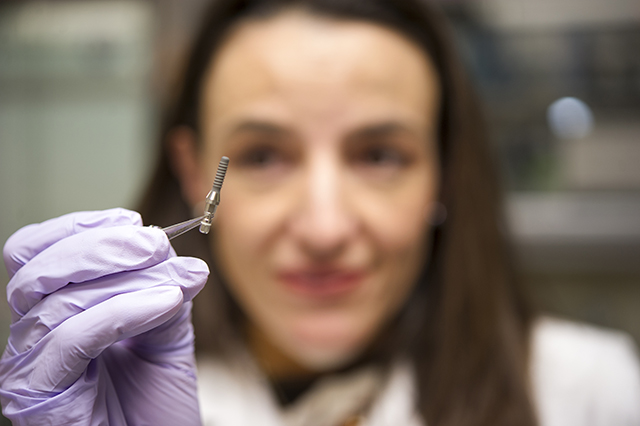Anatomy of implant corrosion

Titanium durability findings prompt more questions, research
Patients faced with the decision of whether dental implants are right for them may have a few more things to consider, following a study conducted by one periodontic faculty member’s interprofessional research team.
“We always thought that implants were the perfect solution for patients — that they wouldn’t get cavities and that once the titanium was in the bone nothing could happen,” says Dr. Pilar Valderrama, assistant professor in periodontics. “We started this retrieval study and learned that implants are also susceptible to peri-implant disease, a condition similar to periodontal disease.”
The findings about titanium durability are prompting research into the dynamics of this popular dental restorative material. An article published in the Nov. 15 Materials Science Journal reveals the factors that cause implant corrosion, which is considered a trigger for peri-implantitis and implant failure. The findings show an acidic environment — most likely brought on by bacteria and inflammatory processes — caused the titanium’s surface to oxidize. The end result: severe implant discoloration, pitting and cracking.
Valderrama organized the research team, a collaborative effort between Texas A&M University Baylor College of Dentistry and the University of Texas at Dallas. Members include adjunct periodontics associate professor Dr. Thomas Wilson, a Dallas-based private practitioner, and Dr. Danieli Rodrigues, assistant professor of bioengineering at UTD. Rodrigues’ research — conducted with the help of UTD graduate, predental and premedical students — focuses on corrosion and failure mechanisms in orthopedic and dental implants.
The team’s work revealed a concerning observation. The corrosion can lead to adverse tissue reactions.
“It’s like if you’re working in the garden, and you get a thorn in your finger and you’re unable to remove it,” says Valderrama. “The following day you’re going to get a big inflammatory reaction because your body is trying to remove that thorn and is unable to do it.”

Trying to undo the damage is no easy task. Detoxifying the implant’s surface is difficult whether surgical or non-surgical treatment methods are used, according to literature reviews Valderrama and Wilson conducted this summer and published in the International Journal of Dentistry and Open Dentistry Journal in December 2013.
“Sometimes the implant can be saved because there is not too much destruction,” says Valderrama, but the best bet is preventing excessive bacteria accumulation before it starts, she adds.
Otherwise, the effects could be permanent, Wilson says.
“If you have an implant that has previously integrated that is attacked by bacteria and the corrosion occurs, it may not be possible to get bone to reattach to this area,” he says.
So what is the impact for oral health care professionals trying to treat patients with problematic dental implants?
“That’s what we don’t know at this point,” adds Wilson. “This is just one of the early studies that we’ve done. It is part of a multi-pronged assessment of disease around implants.”
Researchers at TAMBCD and UTD continue to tap into a treasure trove of ideas based on the initial study, “Titanium Corrosion Mechanisms in the Oral Environment: A Retrieval Study,” which gleaned attention during the American Association of Anatomists Regional Meeting in October with two poster competition awards and during the 2013 Texas A&M Health Science Center CARE Fair, with first-place in the graduate poster competition inter-institutional division. Valderrama is coordinating several related initiatives with the assistance of graduate and predoctoral students at TAMBCD.
Rodrigues, who recently received a $20,000 grant from the American Academy of Implant Dentistry to study the role bacteria and mechanical overload play in implant corrosion, says the ongoing collaboration with TAMBCD has proven beneficial to the student researchers as well.
“This collaboration is of extreme importance to our students because it gives them the opportunity to apply their knowledge in biomaterials science to study and evaluate clinical cases,” Rodrigues says.
—Jenny Fuentes